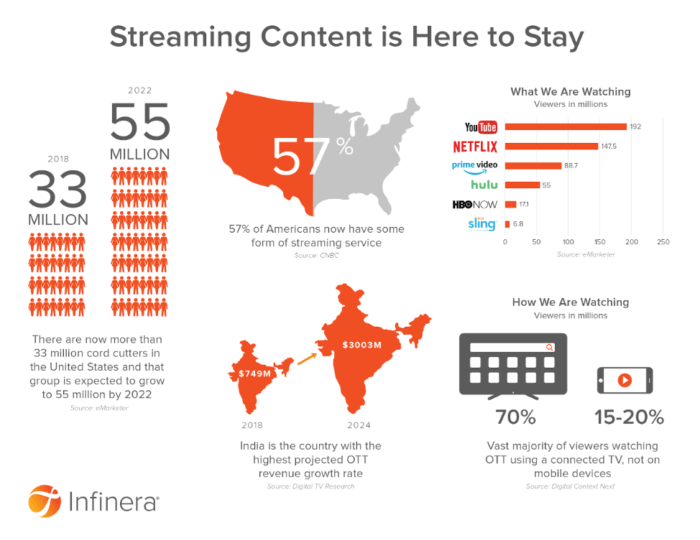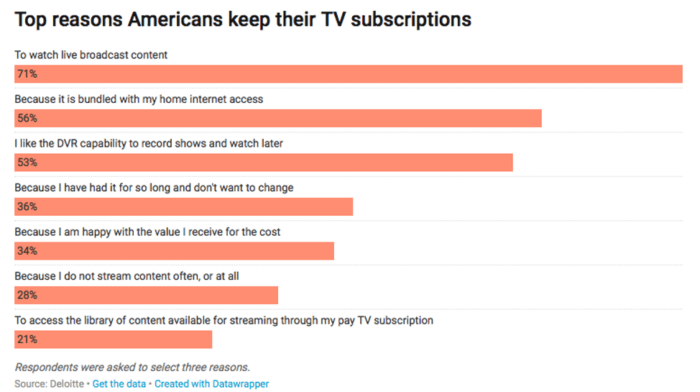Streaming has quickly become the primary source of video consumption within the US and around the world, so what do marketers need to bear in mind?
For most of us, the internet is already the primary source of the videos we watch.
In the US, streaming is headed towards a saturation point. Netflix, Amazon, Hulu, and now Disney + are quickly picking up new subscribers as streaming quickly becomes the primary source of video consumption within the US and globally. Not to mention that YouTube is essentially ubiquitous around the world.
This is important for marketers to take notice of. Not only because traditional TV advertising budgets will soon be replaced by their digital counterparts, but also to understand consumer behavior. Knowing how your customers consume video content helps in a few ways:
- Knowing what your target audience consumes and what platforms they use can help you develop a better digital video ad campaign.
- Knowing what your target audience watches can help you better engage with them on social media (have you seen those baby Yoda memes?)
- Knowing how your target audience uses different video platforms can be helpful in developing an effective content marketing plan.
To give marketers some insight into where video streaming is headed, we’ll go over five interesting video streaming data points and how these apply to marketers.

1. Cable is out, streaming is in
This may seem obvious, but consumers are quickly giving up cable in favor of streaming. In 2018, there were 33 million cord-cutters in the US This number is expected to rise to 55 million by 2022.
Cable and internet companies like AT&T and Comcast know this and are reacting to the change in different ways. Comcast, for example, seems to be embracing the change in some ways by giving away free streaming boxes to their subscribers.
The majority of internet providers, however, seem to be responding by bundling their TV offerings more aggressively with their internet packages. In fact, this is part of the reason there are still 90 million Americans who pay for cable.
Among other reasons Americans still pay for cable include the ability to record shows to watch later, watch broadcast TV content, and a lack of desire to change their ways.
As you can see, while cord-cutting is becoming the norm at an accelerated pace, there is still a large amount of the population that does pay for cable. There’s lots of
evidence that cable users that are sticking around are typically older, while cord-cutters are a part of the younger generations.
What does this mean for marketers?
For marketers, this means that if you’re targeting a younger audience, you should pay attention to what streaming services are putting out to engage your audience on social media. Additionally, allocate your video advertising budget to digital channels.
If you’re targeting an older audience, traditional TV advertising may still be worth the money.
Download our Individual Member Resource – Video and YouTube marketing guide
Our guide to video marketing will help you grow your business online using video content and video platforms.
Access the Video and YouTube marketing guide
2. Streaming is approaching a saturation point within the US
57% of US consumers have access to at least one streaming service. In fact, on average, consumers subscribe to three streaming services.
According to data from Statista, Netflix’ US growth has been relatively flat through 2019 - hovering around 60 million subscribers.
Part of this may be due to the fact that there is an increasing number of competitors entering the market. Disney + is a perfect example, but many Disney + subscribers are likely also Netflix users themselves. Disney and BBC are launching a joint venture called BritBox. With studios launching their own platforms, Netflix is losing access to popular content.
This data illustrates that many streaming platforms are growing by taking subscribers away from other platforms rather than the market as a whole growing.
What does this mean for marketers?
It’s unlikely that marketers will be able to find data that displays the rapid growth of US streaming consumption.
Instead of looking for this to get an idea of what your customers may be watching on streaming services, it’s important to look at the popularity of individual services themselves. With this, you can better understand what your customers are watching.
3. Internationally, streaming is still growing rapidly
As we discussed above, if we look at the US market, we’ll notice that growth is relatively stagnant. However, if we zoom out to take a global look at things, streaming still has some room for growth in international markets.
For example, India’s streaming market is expected to more than triple in growth over the next five years according to a report by Digital TV Research. According to this same report, Asia as a whole is expected to reach $48 billion in streaming revenue over the same time period.
What does this mean for marketers?
If you’re trying to market your business internationally with video advertising, pay special attention to the TV viewing habits of the local market. When it comes to streaming, the rest of the world isn’t caught up to the US yet.
4. The majority of video consumption is on connected TVs, not smartphones
Smartphones and tablets take up a majority of overall internet traffic in the US - 63% to be exact.
With this in mind, along with the fact that a majority of downstreaming internet traffic consists of video content, you’d expect that most video streaming consumption is also on mobile devices. In reality, though, things are quite different.
In fact, a whopping 70% of streaming viewers access streaming services primarily through their connected TV.
What does this mean for marketers?
Knowing where your audience is consuming their video content can help you improve your video advertising strategy. If you know that most consumers are watching streaming content from their TV’s, pair this with the fact that most people are on their phones while they watch TV, and you can piece together a multi-device style ad campaign.
5. YouTube leads the way, but Netflix is a close second
While Netflix has a massive paid subscriber base, YouTube leads the way in the number of users.
What’s interesting is that while people use Netflix for TV shows and movies, YouTube is leveraged as a source of informational content.
Overall, half of YouTube’s users use the platform to find out how to do things they haven’t done before. This means that half of users are entering “how to” searches on the platform.
What does this mean for marketers?
Video marketing isn’t limited to advertising. With YouTube users searching for “how-to” videos at a surprisingly significant rate, YouTube can be leveraged as a content marketing platform for your business.
Conclusion
Ultimately, visuals will always be an important part of any marketing strategy. Today, the most engaging form of visual content is video. Tomorrow? Who knows.
Speaking of visuals, check out this infographic for a quick snapshot at where video streaming is headed.

Nick Dmitry is a digital marketing specialist for
Infinera – a global supplier of solutions that provide the resilient foundation for the largest and most demanding Tier 1 carrier, internet content provider, cable operator, government, and enterprise networks worldwide.










